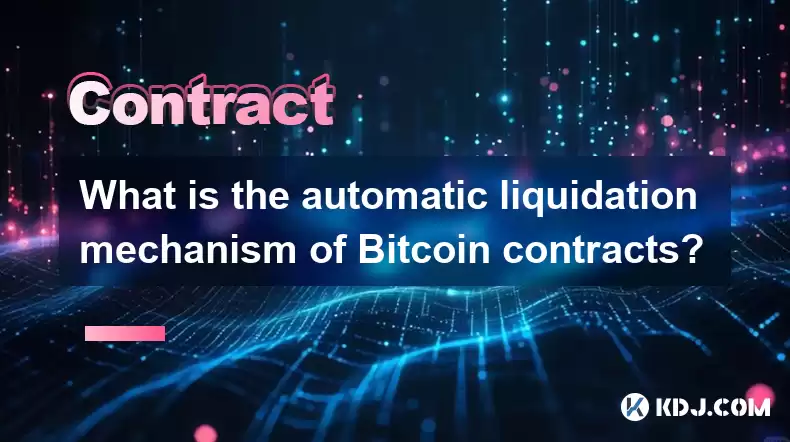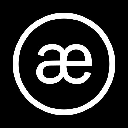-
 bitcoin
bitcoin $109523.663807 USD
-0.13% -
 ethereum
ethereum $4019.526508 USD
2.06% -
 tether
tether $1.000482 USD
0.00% -
 xrp
xrp $2.776815 USD
0.18% -
 bnb
bnb $958.942396 USD
0.12% -
 solana
solana $204.294698 USD
3.84% -
 usd-coin
usd-coin $0.999693 USD
0.00% -
 dogecoin
dogecoin $0.232115 USD
2.09% -
 tron
tron $0.338028 USD
0.84% -
 cardano
cardano $0.790920 USD
1.50% -
 hyperliquid
hyperliquid $44.871443 USD
5.60% -
 ethena-usde
ethena-usde $1.000322 USD
0.04% -
 chainlink
chainlink $21.034165 USD
2.60% -
 avalanche
avalanche $28.794831 USD
-0.54% -
 stellar
stellar $0.360466 USD
1.24%
What is the automatic liquidation mechanism of Bitcoin contracts?
Bitcoin contract liquidation automatically closes leveraged trades when equity falls below the maintenance margin, protecting traders and exchanges from excessive losses. Factors like leverage, volatility, and exchange parameters influence the liquidation price.
Mar 26, 2025 at 06:08 am

- Bitcoin contracts utilize automatic liquidation to mitigate risk for exchanges and traders.
- Liquidation occurs when a trader's margin falls below the maintenance margin requirement.
- The process is automated to prevent significant losses during volatile market conditions.
- Several factors influence liquidation price, including leverage, price volatility, and exchange-specific parameters.
- Understanding liquidation mechanics is crucial for managing risk and avoiding losses in Bitcoin contract trading.
Bitcoin contracts, unlike directly owning Bitcoin, involve leveraged trading. This means you can control a larger amount of Bitcoin than you actually own, amplified by leverage. However, this increased potential for profit also significantly increases risk. Automatic liquidation is a crucial risk management tool built into the system to protect both the trader and the exchange.
The core principle is simple: If the value of your position falls too far, the exchange automatically closes your position to prevent further losses. This prevents you from accumulating significant debt and protects the exchange from potential defaults. This automated process happens without your intervention, hence the term "automatic liquidation."
How does the automatic liquidation process work?The process hinges on two key metrics: the initial margin and the maintenance margin. Your initial margin is the amount of funds you initially deposit to open a position. The maintenance margin is a lower threshold. As long as the equity in your trading account (the value of your position plus your margin) remains above the maintenance margin, your position remains open.
- When the equity drops below the maintenance margin, a margin call is triggered. This is a warning that your position is at risk of liquidation.
- If the price continues to move against your position and your equity falls below a liquidation threshold (usually slightly lower than the maintenance margin), the exchange automatically liquidates your position.
- The exchange sells your Bitcoin contract at the prevailing market price to cover your losses. Any remaining funds after covering losses are returned to your account.
Several factors determine the precise price at which your position is liquidated. These include:
- Leverage: Higher leverage magnifies both profits and losses, leading to liquidation at prices closer to your entry point.
- Volatility: In highly volatile markets, rapid price swings can trigger liquidation even with relatively high equity. Sharp price drops can quickly push your position below the liquidation threshold.
- Exchange-specific parameters: Different exchanges have varying liquidation parameters. These parameters might include a liquidation buffer (a small percentage below the maintenance margin) to give some leeway.
- Order book depth: The availability of buyers at the current market price can impact the actual liquidation price. If there's insufficient liquidity, the liquidation price might be less favorable.
- Liquidation order type: Exchanges often use market orders to liquidate positions quickly, meaning the liquidation price might be slightly different from the last traded price.
Once your position is liquidated, the exchange closes your trade. The proceeds from the sale of your contract are used to cover your debt. If the proceeds are sufficient to cover your debt, you might retain some funds in your account. However, if the proceeds are insufficient, you will likely have a negative balance.
Frequently Asked Questions:Q: Can I prevent automatic liquidation?A: The most effective way to prevent liquidation is to manage your risk properly by using appropriate leverage, setting stop-loss orders, and closely monitoring your position's equity. Adding more margin to your account can also help prevent liquidation if the price moves against your position.
Q: What is a stop-loss order, and how does it relate to liquidation?A: A stop-loss order is a type of order that automatically sells your position when the price reaches a specified level. This can help you limit potential losses and prevent liquidation, acting as a safety net. It is not a replacement for understanding the liquidation mechanics.
Q: Is the liquidation price always the best possible price?A: No, the liquidation price is determined by market conditions and the exchange's mechanisms. It might not be the absolute best price you could have achieved if you had manually closed the position. Rapid price movements and low liquidity can lead to less favorable liquidation prices.
Q: What happens if I have multiple open positions?A: If you have multiple open positions, the exchange might liquidate them sequentially, starting with the position that's closest to liquidation. The order of liquidation may depend on the exchange's specific algorithm.
Q: Can I appeal a liquidation?A: Appealing a liquidation is typically difficult, as the process is automated to ensure fairness and efficiency. Exchanges generally have clear terms of service regarding liquidations, which are usually binding.
Q: How can I understand the liquidation parameters of my exchange?A: Each exchange provides detailed information on its website regarding margin requirements, maintenance margins, liquidation thresholds, and other relevant parameters for trading Bitcoin contracts. Carefully reviewing this information is crucial before initiating leveraged trades.
Disclaimer:info@kdj.com
The information provided is not trading advice. kdj.com does not assume any responsibility for any investments made based on the information provided in this article. Cryptocurrencies are highly volatile and it is highly recommended that you invest with caution after thorough research!
If you believe that the content used on this website infringes your copyright, please contact us immediately (info@kdj.com) and we will delete it promptly.
- Bitcoin, mNAV, and Treasury Companies: A New York Perspective
- 2025-09-28 04:25:14
- BNB Price and the Rise of BlockchainFX: The Crypto Presale to Watch
- 2025-09-28 04:25:14
- Trump, WLFI, and the Token Burn: Can Burning Crypto Make it Great Again?
- 2025-09-28 04:45:15
- James Wynn's 3x Leveraged Crypto Gamble: ASTER Airdrop or Bust?
- 2025-09-28 04:45:15
- Vitalik Buterin Sounds Alarm on EU Legislation: Ethereum's Privacy Stance
- 2025-09-28 05:25:12
- XLM Records, Toncoin Utility, BullZilla Presale: Crypto's Next Big Thing?
- 2025-09-28 05:05:12
Related knowledge

How do I enable the "scalping-only" mode for Cardano (ADA) contracts?
Sep 24,2025 at 03:19am
Understanding Scalping Strategies in Crypto Derivatives1. Scalping in cryptocurrency trading refers to executing multiple short-term trades within min...

What is the settlement time for Cardano (ADA) contracts?
Sep 28,2025 at 04:18am
Understanding Cardano's Contract Settlement Mechanism1. Cardano operates on a proof-of-stake consensus model known as Ouroboros, which fundamentally i...

How do I add margin to Cardano (ADA) contracts?
Sep 27,2025 at 07:54pm
Understanding Margin in Cardano (ADA) Smart ContractsCardano operates on a proof-of-stake blockchain that supports smart contracts through its Plutus ...

What is the maximum position limit for Cardano (ADA) contracts?
Sep 23,2025 at 11:00pm
Understanding ADA Futures and Derivatives Market Structure1. Cardano (ADA) futures contracts are offered by several major cryptocurrency derivatives e...

What is the maker fee for Cardano (ADA) contracts?
Sep 26,2025 at 09:01am
Understanding Maker Fees in Cardano (ADA) Contracts1. The concept of maker fees applies broadly across decentralized exchanges and smart contract plat...

How can I view open interest in Cardano (ADA) contracts?
Sep 24,2025 at 07:36am
Understanding Open Interest in Cardano Derivatives1. Open interest refers to the total number of outstanding derivative contracts, such as futures or ...

How do I enable the "scalping-only" mode for Cardano (ADA) contracts?
Sep 24,2025 at 03:19am
Understanding Scalping Strategies in Crypto Derivatives1. Scalping in cryptocurrency trading refers to executing multiple short-term trades within min...

What is the settlement time for Cardano (ADA) contracts?
Sep 28,2025 at 04:18am
Understanding Cardano's Contract Settlement Mechanism1. Cardano operates on a proof-of-stake consensus model known as Ouroboros, which fundamentally i...

How do I add margin to Cardano (ADA) contracts?
Sep 27,2025 at 07:54pm
Understanding Margin in Cardano (ADA) Smart ContractsCardano operates on a proof-of-stake blockchain that supports smart contracts through its Plutus ...

What is the maximum position limit for Cardano (ADA) contracts?
Sep 23,2025 at 11:00pm
Understanding ADA Futures and Derivatives Market Structure1. Cardano (ADA) futures contracts are offered by several major cryptocurrency derivatives e...

What is the maker fee for Cardano (ADA) contracts?
Sep 26,2025 at 09:01am
Understanding Maker Fees in Cardano (ADA) Contracts1. The concept of maker fees applies broadly across decentralized exchanges and smart contract plat...

How can I view open interest in Cardano (ADA) contracts?
Sep 24,2025 at 07:36am
Understanding Open Interest in Cardano Derivatives1. Open interest refers to the total number of outstanding derivative contracts, such as futures or ...
See all articles










































































